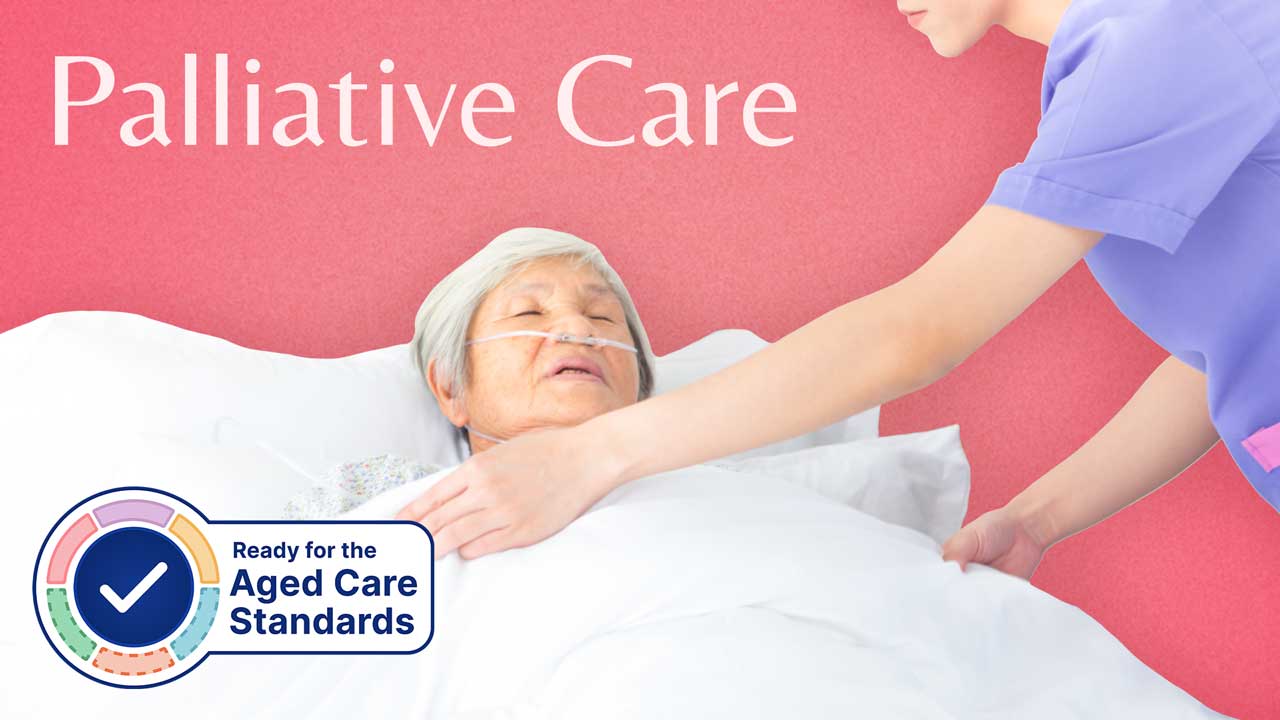Palliative care allows patients with life-limiting illnesses to live as comfortably as possible in their final days.
This overview of palliative care will address some misconceptions and provide practical tips for healthcare staff.
What is Palliative Care?
Palliative care is the care approach taken for patients with life-limiting illness who have little to no prospect of cure, where the primary aim of treatment is comfort care and quality of life. This does not necessarily mean stopping medications, treatments and therapies; rather, it involves refocusing goals depending on the patient’s needs (PCA 2018; Healthdirect 2021).
Palliative care is based on individual needs and is different for each patient, aiming to alleviate physical, emotional, social and/or spiritual difficulties (PCA 2015a).
In addition to reducing pain and distress, palliative care also aims to enhance the patient’s quality of life so they can feel as fulfilled and comfortable as possible. While palliative care might positively influence the course of their illness, the goal is not to quicken nor postpone death (DoHaAC 2019; PCA 2015a).
Some therapies and treatments may be delivered concurrently with palliative care (Better Health Channel 2017).
It’s important to note that palliative care is not exclusive to older adults and can be provided to a patient of any age with a life-limiting illness, including children and young people (DoHaAC 2019).

Palliative Care Under the Strengthened Aged Care Quality Standards
Standard 5: Clinical Care - Outcome 5.7: Palliative and End-of-life care (Action 5.7.3) under the strengthened Aged Care Quality Standards requires aged care organisations to plan and deliver palliative care that:
- Emphasises comfort and respect
- Addresses spiritual, cultural and emotional needs
- Monitors and manages changes in pain and symptoms
- Ensures prompt availability of specialised equipment and medications for pain and symptom relief
- Shares the older person’s preferences for palliative care and their desired care setting with staff, loved ones, carers and others
- Connects with specialised palliative care and end-of-life professionals as needed
- Ensures an appropriate setting for palliative care
- Ensures the older person’s loved ones are provided with information about the dying process, loss and bereavement.
(ACQSC 2024)
What Might Palliative Care Services Include?
- Relief of pain or other uncomfortable symptoms (e.g. vomiting, shortness of breath)
- Equipment and other resources to aid care in the home
- Assistance with daily tasks such as bathing, dressing and eating
- Referrals to services such as home help, financial support and respite care
- Support for patients to meet cultural obligations
- Support for the patient’s emotional, social and/or spiritual life
- Support systems for both the patient and their family
- Counselling and grief support for the patient’s family.
(PCA 2015a; Healthdirect 2021)
Who Might Receive Palliative Care?
A palliative care approach may be taken towards patients with life-limiting illnesses considered active, progressive and advanced, such as (but not limited to):
- Alzheimer’s disease and dementia
- Cancer
- Heart or lung disease
- Motor neurone disease
- Multiple sclerosis
- Renal disease
- Stroke
- Neurological conditions.
(Better Health Channel 2017)
Where Can Palliative Care be Delivered?
Palliative care may be provided:
- At the patient’s home
- In hospital
- In a hospice
- In a residential aged care facility.
(DoHaAC 2019)
This depends on the preferences of the patient and their loved ones (DoHaAC 2019).

Palliative Care v End-of-Life Care
End-of-life care is a phase of palliative care, but palliative care comes before end-of-life care and the two terms are not interchangeable.
End-of-life care occurs in the final stage of a patient’s life when death is imminent. However, palliative care as a whole does not necessarily mean the patient is approaching death. A patient may start palliative care immediately after their diagnosis and receive this care for years (DoHaAC 2019).
What Are the Goals of Palliative Care?
- Relieving suffering
- Enhancing the patient’s quality of life
- Maintaining normality
- Informing and reassuring the patient and the family about the process of dying
- Facilitating patient, family and clinician discussions
- Ensuring the patient and their loved ones have a support network
- Facilitating transparent and honest communication.
(Le 2016)
Practical Tips for Healthcare Professionals
Palliative care involves an interprofessional team of healthcare professionals including doctors, nurses, allied health professionals, carers and/or volunteers.
Here are some tips to keep in mind when caring for a patient receiving palliative care:
- It’s important to initiate discussions about patients’ preferences and wishes in regards to care services and become familiar with their values. Palliative Care Australia has several resources that may help you facilitate these conversations with patients and their loved ones.
- Provide the patient’s family with reassurance around suffering and death. Contrary to some people’s beliefs, death can be a peaceful process that will be comfortable for the patient.
- Advocate for the patient and their wishes if they are not being recognised.
- Ensure care coordination is communicated with the patient and their family.
- Ensure there is adequate communication between all of the parties and services involved in delivering palliative care.
- Surround the patient with the things they love.
- You should be culturally aware and facilitate culturally safe practices.
- Ensure the patient and their loved ones are aware of the services, support and information available to them.
- It is sometimes more important for the patient to consume foods and beverages they enjoy rather than healthier foods, particularly at the end of their life. This will improve their quality of life.
- When children are involved, either as the patient or as family members of the patient, it is important to provide support regarding death that reflects the child’s developmental age.
(Le 2016; Better Health Channel 2015b; PCA 2015b; Farabelli et al. 2020)

National Palliative Care Standards
The National Palliative Care Standards aim to support the delivery of high-quality palliative care. They are:
| Standard 1 | The assessment (initial and ongoing) takes into account the patient’s physical, psychological, cultural, social and spiritual experiences and needs. |
| Standard 2 | The patient and their loved ones work together with carers to plan goals for care and make informed decisions. |
| Standard 3 | The patient’s loved ones and carers are provided support and their needs are met so that they can fulfil their role. |
| Standard 4 | The care delivered is aligned with the needs, values, goals and preferences of the patient, and is informed by evidence. |
| Standard 5 | The delivery of care within and between services is well coordinated. |
| Standard 6 | Loved ones and carers are provided access to information about loss and grief, as well as bereavement support services. |
| Standard 7 | Specialist services support the delivery of person-centred care through their philosophy, values, culture, environment and structure. |
| Standard 8 | Services are involved in ongoing quality improvement practices. |
| Standard 9 | All healthcare staff and volunteers have the required qualifications, training and support to deliver palliative care. |
(Adapted from PCA 2018)
Conclusion
Palliative care involves an interprofessional team of healthcare professionals who aim to alleviate the physical, emotional, social and/or spiritual difficulties of a patient with a life-limiting illness. It is important to individualise this care as well as provide loved ones with adequate support and information about palliative care and death.
Test Your Knowledge
Question 1 of 3
Finish the sentence. Palliative care aims to…
Topics
Further your knowledge



 Free
Free Free
Free Free
Free Free
FreeReferences
- Aged Care Quality and Safety Commission 2024, Standard 5: Clinical Care, Australian Government, viewed 20 June 2024, https://www.health.gov.au/resources/publications/strengthened-aged-care-quality-standards-august-2025?language=en
- Better Health Channel 2017, End of Life and Palliative Care Explained, Victoria State Government, viewed 31 May 2023, https://www.betterhealth.vic.gov.au/health/servicesandsupport/end-of-life-and-palliative-care-explained
- Department of Health and Aged Care 2019, What is Palliative Care?, Australian Government, viewed 31 May 2023, https://www.health.gov.au/topics/palliative-care/about-palliative-care/what-is-palliative-care
- Farabelli, JP et al. 2020, ‘Top Ten Tips Palliative Care Clinicians Should Know About Psychosocial and Family Support’, Journal of Palliative Medicine, vol. 23 no. 2, viewed 31 May 2023, https://www.liebertpub.com/doi/10.1089/jpm.2019.0506
- Healthdirect 2021, Palliative Care, Australian Government, viewed 31 May 2023, https://www.healthdirect.gov.au/palliative-care
- Le, B 2016, Introduction About Palliative Care for Health Professionals, audio podcast, Palliative Care Victoria, viewed 31 May 2023, https://www.pallcarevic.asn.au/page/111/about-palliative-care
- Palliative Care Australia 2018, National Palliative Care Standards, 5th edn, PCA, viewed 31 May 2023, https://palliativecare.org.au/publication/standards/
- Palliative Care Australia 2015b, I am a Health Care Professional, PCA, viewed 31 May 2023, https://palliativecare.org.au/im-a-health-professional/
- Palliative Care Australia 2015a, What is Palliative Care?, PCA, viewed 31 May 2023, https://palliativecare.org.au/resource/what-is-palliative-care/
 New
New 
